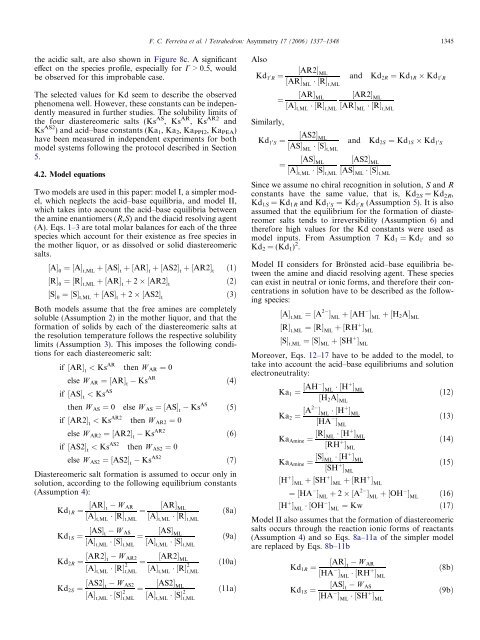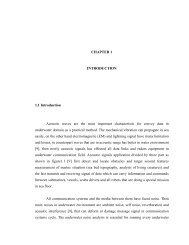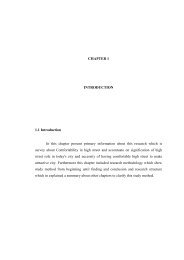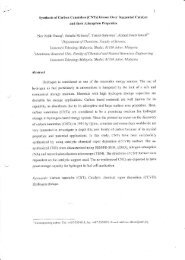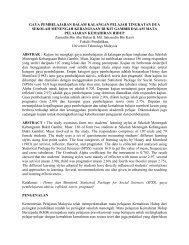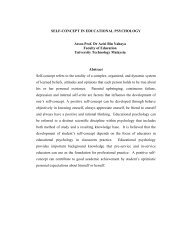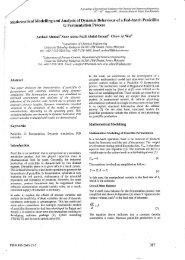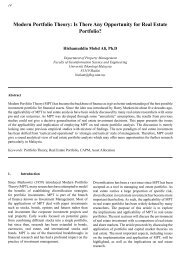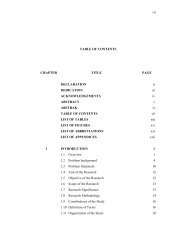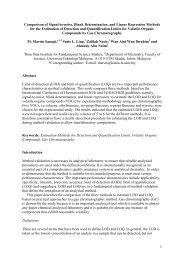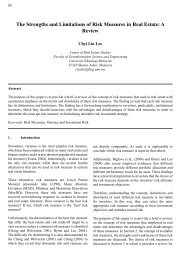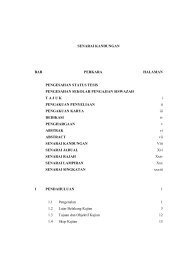Rational approach to the selection of conditions for diastereomeric ...
Rational approach to the selection of conditions for diastereomeric ...
Rational approach to the selection of conditions for diastereomeric ...
You also want an ePaper? Increase the reach of your titles
YUMPU automatically turns print PDFs into web optimized ePapers that Google loves.
F. C. Ferreira et al. / Tetrahedron: Asymmetry 17 (2006) 1337–1348 1345<br />
<strong>the</strong> acidic salt, are also shown in Figure 8c. A significant<br />
effect on <strong>the</strong> species pr<strong>of</strong>ile, especially <strong>for</strong> C > 0.5, would<br />
be observed <strong>for</strong> this improbable case.<br />
The selected values <strong>for</strong> Kd seem <strong>to</strong> describe <strong>the</strong> observed<br />
phenomena well. However, <strong>the</strong>se constants can be independently<br />
measured in fur<strong>the</strong>r studies. The solubility limits <strong>of</strong><br />
<strong>the</strong> four <strong>diastereomeric</strong> salts (Ks AS , Ks AR , Ks AR2 and<br />
Ks AS2 ) and acid–base constants (Ka 1 ,Ka 2 ,Ka PPI2 ,Ka PEA )<br />
have been measured in independent experiments <strong>for</strong> both<br />
model systems following <strong>the</strong> pro<strong>to</strong>col described in Section<br />
5.<br />
4.2. Model equations<br />
Two models are used in this paper: model I, a simpler model,<br />
which neglects <strong>the</strong> acid–base equilibria, and model II,<br />
which takes in<strong>to</strong> account <strong>the</strong> acid–base equilibria between<br />
<strong>the</strong> amine enantiomers (R,S) and <strong>the</strong> diacid resolving agent<br />
(A). Eqs. 1–3 are <strong>to</strong>tal molar balances <strong>for</strong> each <strong>of</strong> <strong>the</strong> three<br />
species which account <strong>for</strong> <strong>the</strong>ir existence as free species in<br />
<strong>the</strong> mo<strong>the</strong>r liquor, or as dissolved or solid <strong>diastereomeric</strong><br />
salts.<br />
½AŠ 0<br />
¼½AŠ t;ML<br />
þ½ASŠ t<br />
þ½ARŠ t<br />
þ½AS2Š t<br />
þ½AR2Š t<br />
ð1Þ<br />
½RŠ 0<br />
¼½RŠ t;ML<br />
þ½ARŠ t<br />
þ 2 ½AR2Š t<br />
ð2Þ<br />
½SŠ 0<br />
¼½SŠ t;ML<br />
þ½ASŠ t<br />
þ 2 ½AS2Š t<br />
ð3Þ<br />
Both models assume that <strong>the</strong> free amines are completely<br />
soluble (Assumption 2) in <strong>the</strong> mo<strong>the</strong>r liquor, and that <strong>the</strong><br />
<strong>for</strong>mation <strong>of</strong> solids by each <strong>of</strong> <strong>the</strong> <strong>diastereomeric</strong> salts at<br />
<strong>the</strong> resolution temperature follows <strong>the</strong> respective solubility<br />
limits (Assumption 3). This imposes <strong>the</strong> following <strong>conditions</strong><br />
<strong>for</strong> each <strong>diastereomeric</strong> salt:<br />
if ½ARŠ t<br />
< Ks AR <strong>the</strong>n W AR ¼ 0<br />
else W AR ¼½ARŠ t<br />
Ks AR ð4Þ<br />
if ½ASŠ t<br />
< Ks AS<br />
<strong>the</strong>n W AS ¼ 0 else W AS ¼½ASŠ t<br />
Ks AS ð5Þ<br />
if ½AR2Š t<br />
< Ks AR2 <strong>the</strong>n W AR2 ¼ 0<br />
else W AR2 ¼½AR2Š t<br />
Ks AR2 ð6Þ<br />
if ½AS2Š t<br />
< Ks AS2 <strong>the</strong>n W AS2 ¼ 0<br />
else W AS2 ¼½AS2Š t<br />
Ks AS2 ð7Þ<br />
Diastereomeric salt <strong>for</strong>mation is assumed <strong>to</strong> occur only in<br />
solution, according <strong>to</strong> <strong>the</strong> following equilibrium constants<br />
(Assumption 4):<br />
Kd 1R ¼ ½ARŠ t<br />
W AR ½ARŠ<br />
¼<br />
ML<br />
½AŠ t;ML<br />
½RŠ t;ML<br />
½AŠ t;ML<br />
½RŠ t;ML<br />
ð8aÞ<br />
Kd 1S ¼ ½ASŠ t<br />
W AS<br />
½AŠ t;ML<br />
½SŠ t;ML<br />
¼<br />
½ASŠ ML<br />
½AŠ t;ML<br />
½SŠ t;ML<br />
Kd 2R ¼ ½AR2Š t<br />
W AR2 ½AR2Š<br />
¼<br />
ML<br />
½AŠ t;ML<br />
½RŠ 2 t;ML<br />
½AŠ t;ML<br />
½RŠ 2 t;ML<br />
Kd 2S ¼ ½AS2Š t<br />
W AS2 ½AS2Š<br />
¼<br />
ML<br />
½AŠ t;ML<br />
½SŠ 2 t;ML<br />
½AŠ t;ML<br />
½SŠ 2 t;ML<br />
ð9aÞ<br />
ð10aÞ<br />
ð11aÞ<br />
Also<br />
Kd 1 0 R ¼<br />
½AR2Š ML<br />
½ARŠ ML<br />
½RŠ t;ML<br />
and Kd 2R ¼ Kd 1R Kd 1 0 R<br />
½ARŠ<br />
¼<br />
ML<br />
½AR2Š ML<br />
½AŠ t;ML<br />
½RŠ t;ML<br />
½ARŠ ML<br />
½RŠ t;ML<br />
Similarly,<br />
½AS2Š<br />
Kd 1 0 S ¼<br />
ML<br />
½ASŠ ML<br />
½SŠ t;ML<br />
and Kd 2S ¼ Kd 1S Kd 1 0 S<br />
½ASŠ<br />
¼<br />
ML<br />
½AS2Š ML<br />
½AŠ t;ML<br />
½SŠ t;ML<br />
½ASŠ ML<br />
½SŠ t;ML<br />
Since we assume no chiral recognition in solution, S and R<br />
constants have <strong>the</strong> same value, that is, Kd 2S =Kd 2R ,<br />
Kd 1S =Kd 1R and Kd 1 0 S ¼ Kd 1 0 R (Assumption 5). It is also<br />
assumed that <strong>the</strong> equilibrium <strong>for</strong> <strong>the</strong> <strong>for</strong>mation <strong>of</strong> diastereomer<br />
salts tends <strong>to</strong> irreversibility (Assumption 6) and<br />
<strong>the</strong>re<strong>for</strong>e high values <strong>for</strong> <strong>the</strong> Kd constants were used as<br />
model inputs. From Assumption 7 Kd 1 ¼ Kd 1<br />
0 and so<br />
Kd 2 = (Kd 1 ) 2 .<br />
Model II considers <strong>for</strong> Brönsted acid–base equilibria between<br />
<strong>the</strong> amine and diacid resolving agent. These species<br />
can exist in neutral or ionic <strong>for</strong>ms, and <strong>the</strong>re<strong>for</strong>e <strong>the</strong>ir concentrations<br />
in solution have <strong>to</strong> be described as <strong>the</strong> following<br />
species:<br />
½AŠ t;ML<br />
¼½A 2 Š ML<br />
þ½AH Š ML<br />
þ½H 2 AŠ ML<br />
½RŠ t;ML<br />
¼½RŠ ML<br />
þ½RH þ Š ML<br />
½SŠ t;ML<br />
¼½SŠ ML<br />
þ½SH þ Š ML<br />
Moreover, Eqs. 12–17 have <strong>to</strong> be added <strong>to</strong> <strong>the</strong> model, <strong>to</strong><br />
take in<strong>to</strong> account <strong>the</strong> acid–base equilibriums and solution<br />
electroneutrality:<br />
Ka 1 ¼ ½AH Š ML ½Hþ Š ML<br />
½H 2 AŠ ML<br />
ð12Þ<br />
Ka 2 ¼ ½A2 Š ML<br />
½H þ Š ML<br />
½HA Š ML<br />
ð13Þ<br />
Ka Amine ¼ ½RŠ ML ½Hþ Š ML<br />
½RH þ Š ML<br />
ð14Þ<br />
Ka Amine ¼ ½SŠ ML ½Hþ Š ML<br />
½SH þ Š ML<br />
ð15Þ<br />
½H þ Š ML<br />
þ½SH þ Š ML<br />
þ½RH þ Š ML<br />
¼½HA Š ML<br />
þ 2 ½A 2 Š ML<br />
þ½OH Š ML<br />
ð16Þ<br />
½H þ Š ML<br />
½OH Š ML<br />
¼ Kw<br />
ð17Þ<br />
Model II also assumes that <strong>the</strong> <strong>for</strong>mation <strong>of</strong> <strong>diastereomeric</strong><br />
salts occurs through <strong>the</strong> reaction ionic <strong>for</strong>ms <strong>of</strong> reactants<br />
(Assumption 4) and so Eqs. 8a–11a <strong>of</strong> <strong>the</strong> simpler model<br />
are replaced by Eqs. 8b–11b<br />
½ARŠ<br />
Kd 1R ¼<br />
t<br />
W AR<br />
½HA Š ML<br />
½RH þ Š ML<br />
ð8bÞ<br />
½ASŠ<br />
Kd 1S ¼<br />
t<br />
W AS<br />
½HA Š ML<br />
½SH þ Š ML<br />
ð9bÞ


